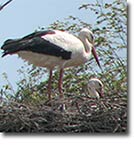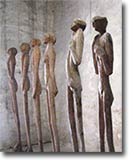![]()
![]()
April 25
Burg - Parey - Tangermuende
April 26
Parey - Tangermuende
April 27
Tangermuende - Arneburg
April 28
Arneburg - Sandau
| Angie Littlefield • Tangermuende |
Check out the Photo Galleries: 1, 2, 3, 4 , 5, 6, 7, 8, 9, 10, Traces In the middle Elbe area it's common to see storks' nests on top of specially erected perches and on chimney tops. It is considered good luck to have a stork's nest. I've seen lots nests and storks but never, as today, an overhead display of about 4-5 storks who flew quite close to where we were. You could hear the beak clacking that they use to signal to one another. Frogs Judy and I saw a frog crossing sign and lots of netting put up to protect frogs from road deaths. Today as I approached a wetland near Hamerton I heard hundreds of frogs in full song. I tried to creep up to take a photo but wherever I crept, there was silence. I finally just snapped the pond; the rest is up to the imagination. Bridge Dead Tangermuende was a highly contested area in WWII as the Americans raced to take the bridge for the advance on Berlin. There was hand to hand fighting and there were American tanks blown up right in the area where David and I were walking today. As I walked out of Tangermuende earlier in the day, I saw the new bridge and behind it the old railway bridge where lives were lost in defence of the bridge in WWII. This is an area steeped in history. Sunday, April 27 ~ Church Service I was an hour ahead of my pick up and as a very strange coincidence there was a church service going on in Storkau at the evangelical church. I took off my tourist gear and went in to join five other worshippers.
After a 2.5 hour tour of Tangermuende we finally ended up in a city tower. We went up five or so levels of steps to have panoramic views of the area. Along the way there were some haunting statues by an artist called Adler. Ironically the twin Adler was the sign of the Hansa City Tangermuende. Peter Adler, Sculptor, Painter, Graphic Artist We encountered Peter Adler's sculptures as we turned the corner about three flights up one of Tangermuende's city towers. There they were, a group of beings, caught shivering in the scant light. I found them hauntingly reminiscent of Holocaust victims; David, on the other hand, wanted his photo taken with one of his new 'friends''! Peter Adler, born in Magedburg, has been a professional artist since 1987. After many study and work voyages he now lives in Altmark and Berlin. On his website you find examples of his extraordinary works, a map indicating where his work has taken him and contact information. www.artler.de
April 28 Tangermuende
I noticed a group of ten or so cows roaming loose without a fence between me and them. Way down in the field was a herder. I started taking photos when the boisterous group took an interest in me. When they got within 20 feet I put down the camera. They were snorting and pawing the ground. What now? Using my best principal voice, I raised my finger and yelled, "Stay!!" They stopped, looked at me, looked behind at the advancing herder and took off down the bicycle path in the direction from whence I'd come. Although I later chortled at the sight of the herder in a blue mini car pursuing the wild cows down the bike path, I had to wait for the adrenalin to calm down. Hoppe, Hoppe Reiter In the vast farmlands between Arneburg and Sandau there were many irrigation ditches. As a child I learned the nursery rhyme, "Hoppe, Hoppe Reiter" which is recited while jostling babies on one's lap. It's the only bit of German our daughter knows. It translates to, "Hop, hop, you rider/ If you fall you'll cry/ If you fall into the ditch, the ravens will eat you/ If you fall into the swamp, then the rider will go—making a whooping sound as the child is released backwards. Those fun-loving Germans!! On this day of walking I took photos of ditches and swamps. There are always lots of ravens. They just won't pose! |
Angie Littlefield | 416.282.0646 | angie.littlefield@yahoo.ca |

 Storks
Storks


